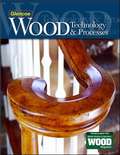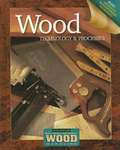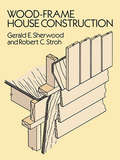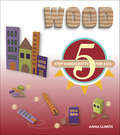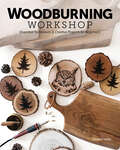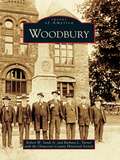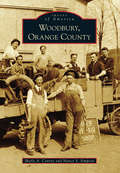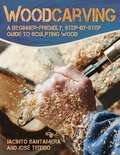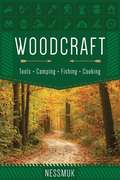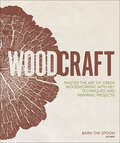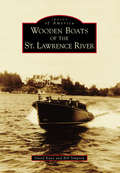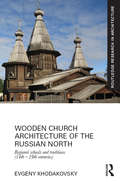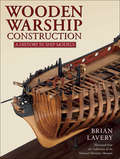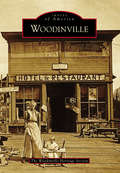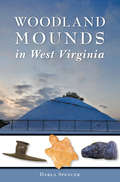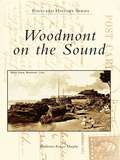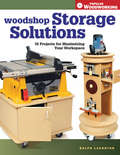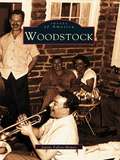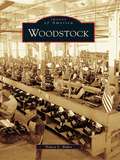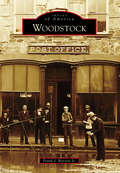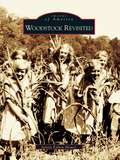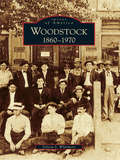- Table View
- List View
Wood Technology & Processes
by John L. Feirer Mark D. FeirerHelp students learn about today's woodworking techniques and tools with Glencoe Wood Technology and Processes! Comprehensive content with basic and advanced woodworking operations offers clear instructions and a strong illustration program. The Woodworkers Handbook identifies tools and materials used in woodworking; Advanced Woodworking Techniques offers advanced techniques for the experienced woodworker. Academic Integration is provided in every chapter with Math and Science features. Beginner, intermediate, and advanced projects from Better Homes and Gardens® Wood Magazine provide projects using skills learned in the text. Projects include a compact disc tower, a drafting/reference center, a birdhouse in the round, a doghouse, and more, giving your students practical, enjoyable experiences working with wood!
Wood Technology and Processes
by Mcgraw-Hill Staff Norm Abram"Wood Technology & Processes" is a comprehensive woodworking text for high school that introduces basic and advanced woodworking operations with clear instructions and illustrations. Besides the "Woodworker's Handbook," and a four-color presentation of the tools and materials of the woodworker, this edition has a-new section on "Advanced Woodworking Techniques," including clamping techniques, router table techniques, face framing, use of the miniature lathe, and step-by-step instructions on how to make various kinds of joints. New projects with detailed step-by-step procedures have been added to the "Better Homes and Gardens(R) WOOD(R)" Magazine Projects at the back of the book.
Wood-Frame House Construction: A Do-it-yourself Guide
by Gerald E. Sherwood Robert C. StrohFirst published in 1955 as U.S. Department of Agriculture Handbook No. 73, this highly popular guide presents sound, time-tested principles for wood-frame house construction, complete with expert advice on selecting suitable building materials. For this edition, it has been completely revised and updated to incorporate advances in home building brought about by the availability of new materials, use of more manufactured components, and changes in construction techniques. Chapter 1 covers the preliminaries that should be considered or dealt with before beginning construction ― financial planning, site selection, design, etc.Chapters 2–4 discuss laying the groundwork (including foundations, footings, and retaining walls), framing and closing in ― describing each step in the order it is usually completed. Chapters 5–7 describe later tasks that don't necessarily have to be done in the order they are presented. Topics include porches, decks, interior wall framing, plumbing, heating and electric installation, flooring, interior finishes, cabinets, and more. Chapter 8 covers special topics often associated with wood-frame construction: protection against decay and termites, energy conservation, all-weather construction, maintenance and repair, and other matters. Technical notes, an annotated list of suggestions for additional reading, and a glossary round out the book. Clear, thorough, and easy to follow, with nearly 200 helpful illustrations, Wood-Frame House Construction offers a detailed, informative guide to construction techniques invaluable for the do-it-yourselfer or as a review for the professional.
Wood: 5-Step Handicrafts for Kids (5-Step Handicrafts for Kids)
by Anna LlimosIn just five simple steps, children can make a variety of whimsical objects such as race cars, a rabbit, a puzzle, and a marble run out of wood. Fourteen projects make clever use of commonly available materials and simple tools, turning clothespins, corkboard, and wooden blocks into lasting crafts and toys. Children five years and older will develop fine motor skills, feed their creativity, and be encouraged to find new uses for everyday objects.
Woodburning Workshop: Essential Techniques & Creative Projects for Beginners
by Court O'ReillyLearn to burn! Woodburning, also known as pyrography, is a craft on the rise and now you can learn how to get started with the expert advice in this book from the renowned wood artist, Court O’Reilly. The book starts with an introduction to the necessary tools and supplies. You’ll learn how to pick the wood burner that is right for you and how to safely use it. You’ll start simply by learning how to burn straight lines, curved lines, shapes, and letters. Then, you will progress on to more complex skills such as shading and making intricate textures like scales. After you have mastered the basics, you will move on to a series of ten artistic projects, each one presenting a new skill, technique, or concept. You’ll practice lettering while making a beautiful welcome sign and shading while making a gorgeous charcuterie board with flowers. Eventually, you will advance to making detailed wildlife portraits with realistic features such as fur and eyes. Each project is truly unique and totally within your reach. Create 10 artistic nature-inspired projects, each one presenting a new skill, technique, or concept Nature lovers and those who love rustic design will enjoy the slow, meditative, and sensory craft Using just a few tools and simple, easy-to-get materials you, too, can create works of art
Woodbury
by Robert W. Sands Jr. Barbara L. Turner Gloucester County Historical SocietyWoodbury possesses a rich heritage that reads like the story of America. Established in 1683 by Quakers seeking religious freedom, the community was occupied for three days by British troops under Gen. Charles Cornwallis during the Revolutionary War. In 1787, Woodbury became the county seat of Gloucester County, and it remains so to this day. It was home to Capt. James Lawrence, who coined the phrase "Don't give up the ship" during the War of 1812. Woodbury features views of the lavish homes built by prominent residents, scenes of the 1904 train wreck, and never-before-published images of the Broad Street business district in the mid-1900s.
Woodbury, Orange County (Images of America)
by Nancy S. Simpson Sheila A. ConroyNestled in the ridges and valleys of the lower Hudson Valley, Woodbury was home to Quaker farmers before the Revolutionary War. As the country grew, railroads, and then cars, brought visitors to enjoy the town's salubrious air, healthful food, and outdoor recreation. Carriage trade hotels, boardinghouses, and farms all hosted year-round vacationers. People as diverse as the first president of Cuba, Tomas Estrada Palma; New York governor Averell Harriman; and burlesque queen Gypsy Rose Lee all had homes in Woodbury. Once known as the home of the incomparable Leonard and Payne fishing rods, today the town is internationally recognized as the home of the Woodbury Common Outlet Center. In Woodbury, Orange County, early Central Valley, Highland Mills, and the hamlet of Woodbury Falls, which is no more, are seen again in vintage photographs.
Woodcarving: A Beginner-Friendly, Step-by-Step Guide to Sculpting Wood
by José Teixido Jacinto SantameraEverything You Need to Know to Start Carving Wood or Hone Your Craft. Woodcarving, with its cultural roots in African, North American, and Oceanic cultures, has been a powerful art form for centuries. Woodcarving reviews this rich history, then focuses on the properties of various woods and the sculpting, sharpening, and finishing tools used on them. Various chapters are devoted to constructing the wood block, carving and handling wood, and finishing and displaying the piece. Anchoring and amplifying the lessons learned within this book are detailed demonstrations of the creation of six sculptures. With clear, lavishly illustrated hands-on instruction and exhaustive coverage of every aspect of woodcarving techniques, Woodcarving is the ideal handbook for beginning- to intermediate-level sculptors.
Woodcraft
by NessmukLegendary canoeing guide, conservationist in the 1800s, and one of the first proponents of the hyper popular "ultra-light” camping style, George Washington "Nessmuk” Sears was a true American mountain man. Using a 9-foot-long, 10 and a half pound canoe he successfully completed a 266-mile journey through the central Adirondacks. His classic treatise on American camping, Woodcraft , is definitive proof that he was the most capable and intelligent woodsman of his time.First published in 1884, and continuously in print ever since then, this is the ultimate book for hikers, campers, fishers, canoers, and anyone else who feels the call of the wild. With information on what to bring, how to build fires, how to fish with and without flies, and how to cook, this book is still totally relevant in our modern society. For anyone with even a passing interest in getting closer to nature this is required reading. The forerunner of the ultra-light camping movement and the precursor to all other books on camping and traveling through the wilderness, Woodcraft belongs on the bookshelf of every aspiring mountain person.Skyhorse Publishing is proud to publish a broad range of books for fishermen. Our books for anglers include titles that focus on fly fishing, bait fishing, fly-casting, spin casting, deep sea fishing, and surf fishing. Our books offer both practical advice on tackle, techniques, knots, and more, as well as lyrical prose on fishing for bass, trout, salmon, crappie, baitfish, catfish, and more. While not every title we publish becomes a New York Times bestseller or a national bestseller, we are committed to publishing books on subjects that are sometimes overlooked by other publishers and to authors whose work might not otherwise find a home.
Woodcraft: Master the Art of Green Woodworking with Key Techniques and Inspiring Projects
by Barn the SpoonLooking for a simpler, more natural way of working with wood? Create beautiful wooden objects from fresh green wood by becoming skilled in the crafts of whittling, ax-based furniture making, turning, and weaving.With green woodworking there's no need for costly materials and machinery. All you need to begin crafting is a log, an ax, and a hand knife.Starting with selecting and splitting your very first log, let Woodcraft show you all the techniques of green woodworking and guide you step by step through a series of rewarding projects.Learn to carve your own spoons, bowls, shrink boxes, and other objects; construct simple pieces of furniture, such as stools and side tables; turn wood on a pole lathe; and weave with willow rods and birch bark.Woodcraft brings up-to-date a newly resurgent folk craft and makes it truly accessible to all--no workshop required. So, what are you waiting for? Get in touch with nature and find harmony working with your hands.
Wooden Boats of the St. Lawrence River (Images of America)
by Bill Simpson David KunzThe Thousand Islands’ very name conjures up images of great natural beauty and nautical wonders. They are forested islands replete with storybook stone castles. Exquisite mahogany runabouts can be seen speeding across the placid surface of the mighty St. Lawrence. Names like Boldt, Bourne, Emery, Lyon, and Pullman are embedded in the Golden Age of the area, and it all comes to life in this pictorial history of the river. Images of America: Wooden Boats of the St. Lawrence River tells the story of the rich and powerful men who constructed castles and built classic wooden boats in the Thousand Islands. At the center of the story loom David and Charlie Lyon.
Wooden Church Architecture of the Russian North: Regional Schools and Traditions (14th - 19th centuries) (Routledge Research in Architecture)
by Evgeny KhodakovskyThe book presents a broad panoramic overview of church architecture in the Russian North between the fourteenth and nineteenth centuries. While it is inevitably overshadowed by the imperial splendour of the country’s capital cities, this unique phenomenon is regarded as the most distinctive national expression of traditional Russian artistic culture and at the same time as a significant part of humanity’s worldwide architectural heritage. The chief intention of the book is to present the regionally specific features of the wooden churches of the Russian North, which vary from area to area for local natural or historical reasons. This approach touches upon the very important questions of the typology and classification of the multiplicity of architectural forms. The "regional view" entails giving clear definitions of the ambiguous terms "architectural school" and "tradition", explaining the origins and shaping impulses for the different regional clusters of objects. Structurally the book presents a history of the development of wooden church architecture in the Russian North and then follows the key points of the mediaeval Russian expansion along the waterways from Novgorod into the North – he Svir’ River, Lake Onego, the town of Kargopol’ and the River Onega, the White Sea, the Rivers Dvina, Pinega and Mezen’ – those areas that still retain the most splendid pieces of Russian regional wooden church architecture. The study is based on field research and provides an up-to-date, multi-faceted view of Russian wooden architecture.
Wooden Warship Construction: A History in Ship Models
by Brian LaveryThe National Maritime Museum in Greenwich houses the largest collection of scale ship models in the world, many of which are official, contemporary artifacts made by the craftsmen of the navy or the shipbuilders themselves, and ranging from the mid seventeenth century to the present day. As such they represent a three-dimensional archive of unique importance and authority. Treated as historical evidence, they offer more detail than even the best plans, and demonstrate exactly what the ships looked like in a way that even the finest marine painter could not achieve. This book takes a selection of the best models to both describe and demonstrate the development of warship construction in all its complexity from the beginning of the 18th century to the end of wooden shipbuilding. For this purpose it reproduces a large number of model photos, all in full color, and including many close-up and detail views. These are captioned in depth, but many are also annotated to focus attention on interesting or unusual features, which can be shown far more clearly than described. Although pictorial in emphasis, the book weaves the pictures into an authoritative text, producing an unusual and attractive form of technical history.
Woodinville
by The Woodinville Heritage SocietyThe community of Woodinville, located northeast of Seattle across Lake Washington, traces its origins to Ira and Susan Woodin, who arrived in 1871. The young family rowed their boat from Seattle across the lake, then up a wide, sluggish stream called Squak Slough (later Sammamish River) to settle on 160 forested acres. Joined by more settlers within 10 years, the small settlement was first defined by logging camps and sawmills. The Seattle, Lake Shore & Eastern Railroad came to town in 1887, tying the community to the neighboring settlements and bringing more homesteaders. After the timber was removed from the river valley, large-scale farming and dairying took over the fertile area for the next 60 years, culminating in a viticulture industry that has given the once-bucolic valley a national reputation for wineries and tasting rooms.
Woodlake
by Marsha IngraoKnown as the area "within the magic circle," the Western town of Woodlake, along with its surrounding valley, is rich in both natural resources and hardworking citizens who are proud of their heritage. Most Tulare County towns sprang up along the Southern Pacific Railroad. Woodlake, designed as a tourist town, drew together farming communities, consisting of people too busy raising fruit and cattle to create a town. Starting with Thomas Henry Davis in 1853, settlers established farms and ranches, which attracted Los Angeles millionaire Gilbert Stevenson when he arrived in 1907. Approved by the Tulare County Board of Supervisors on October 3, 1911, the world-class tourist town named Woodlake grew from Stevenson's imagination into reality. Led by the strong sales personality of its founder, Woodlake grew quickly, yet it remained a Western town, retaining reference points to the early communities that visitors would not find on signs. Visitors to Woodlake today will find Woodlakeans still doing what attracted Gilbert Stevenson: raising cattle and growing citrus within protection of the Sierra Nevada and foothills.
Woodland Mounds in West Virginia (American Heritage)
by Darla SpencerThe first Europeans to arrive in the Ohio Valley were intrigued and puzzled by the many conical earthen mounds they encountered there. They created wild theories about who the mysterious "Moundbuilders" might be. It was not until the 1880s that Smithsonian Institution investigations revealed that the Moundbuilders were the ancestors of living Native Americans. More than four hundred mounds have been recorded in West Virginia, including the Grave Creek Mound in Marshall County, the largest conical mound in North America. Join archaeologist Darla Spencer and learn about the Grave Creek Mound and fifteen additional Adena mounds from the fascinating Woodland period in West Virginia.
Woodland Park
by Pikes Peak Museum Ute Pass Historical SocietyWoodland Park, at an altitude of nearly 8,500 feet, is located 18 miles west of Colorado Springs along the north slope of Pikes Peak in eastern Teller County. Much of the history of the West passed through this area on the old Ute Trail--now Highway 24--as hunters, trappers, cowboys, Native Americans, settlers, miners, railroaders, ranchers, and tourists discovered an abundance of natural beauty and varied business opportunities through the years. Woodland Park is now home to about 8,000 year-round residents, many of whom treasure not only the spectacular scenery but also the rich past of the town. This evocative tour through that past shares vintage photographs collected by the Ute Pass Historical Society.
Woodmont on the Sound (Postcard History Series)
by Katherine Krauss MurphyWoodmont on the Sound inhabits a small corner of the world: one square mile with a mile and a half of shoreline on Long Island Sound. It is a borough within the city of Milford, and at the beginning of the 20th century it became a popular summer resort, as trolleys ran through the area from New Haven to Bridgeport. Stately wooden hotels, inns, and cottages welcomed guests for days, weeks, or the entire summer season. Woodmont was a destination for those seeking sun, swimming, boating, and fishing during the hot summer months. Before electricity, telephones, and automobiles, postcards were a fun and vital communication between Woodmont residents and the outside world.
Woodshop Storage Solutions: 16 Projects for Maximizing Your Workspace
by Ralph LaughtonProjects for reinventing your woodshopAre you constantly looking for better and more efficient ways of storing and using your tools? By the time you've collected your tools, gathered materials and started working on your woodworking projects, space can be at a premium. This book contains 16 ingenious projects that will make your woodshop totally efficient, extremely flexible and very safe.Projects include:Chisel rackSandpaper pressSmall-items chestRouter-cutters-storage cabinetDrill press cabinetTool tote and stoolSmall offcuts storage trolleyWall-hung tool cabinetDowndraft tableClamp rackMobile table saw standOutfeed tableFreestanding cabinetRouter trolleyComputer stationRouter table
Woodstock
by Janine Fallon-MowerOrganized as a town in 1787, Woodstock has since been defined by a triangle of three distinct and powerful influences, weaving an uneasy balance: the legacies of the arts and crafts colony established at Byrdcliffe, the 1969 Woodstock Music Festival held in Bethel, and the people who live and work and raise families in the community. Woodstock provides a fascinating look at the community from the 1890s through the 1980s. With more than two hundred stunning images, it revisits the days when the center was simply a sleepy grass-covered village square. Shown are many buildings that no longer exist: the boarding homes, the icehouses, the bowling alley. The story captures the community as it passes through the arts-colony and music-festival years to become the busy tourist town it is today.
Woodstock
by Nancy L. BakerWelcome to Woodstock, a picturesque Victorian town built around a town square. Originally called Centerville, Woodstock was selected as the county seat of McHenry County in 1843 because of its location almost exactly in the center of the county. Over the decades, Woodstock has welcomed those who came to conduct personal, legal, and civic business on the Woodstock square, to work in Woodstock's typewriter, die casting, and other factories, to attend theatrical productions at the opera house and band concerts in the park. Woodstock residents and those from surrounding towns gathered in Woodstock to see McHenry County's service men and women off to war, to welcome them home and celebrate their safe return, to mourn those who gave their lives, and to honor all who served.
Woodstock (Images of America)
by Frank J. Jr.Set in outstanding natural beauty, many Vermont communities have a unique sense of history and place, and Woodstock has long been considered among the most vibrant and beautiful of them all. Nestled within the eastern foothills of the Green Mountains and the Ottauquechee River valley, from the time of its founding in 1761, the story of Woodstock has been a tapestry rich with culture, architecture, and events. Early in the town’s development, Woodstock was designated by Vermont as the seat of government for Windsor County, and in turn, this brought an influx of lawyers and other professionals together with business and real estate entrepreneurs. The joining of several early turnpikes in Woodstock meant more travelers through town. In years after 1875, when the Woodstock Railway opened, the town became an even greater hub for tourists and those on business. By the early 20th century, Woodstock with its great scenic beauty was recognized as a premier destination for year-round recreation.
Woodstock 1969: The Lasting Impact of the Counterculture
by Jason Lauré Ettagale BlauerAs the fiftieth anniversary of the Woodstock festival nears, Woodstock 1969 stands out for its singular voice. Photojournalist Jason Lauré followed his unerring instinct for being in the right place at the crucial moment. He and coauthor Ettagale Blauer trace the historic events that preceded the festival and then envelop the reader with photographs of the headliner rock stars that performed during the landmark three-day concert including the Who, Janis Joplin, Grace Slick of Jefferson Airplane, and Santana. <p><p> Threading his way back and forth from the stage, through a sea of happy audience members, Jason Lauré photographed the communal life that was an essential part of the phenomenon that was Woodstock. Never intrusive, yet working close-up, he managed to capture these innocent moments in the pond and in the woods with the same compassion and intimacy he brought to his coverage of all the crucial events of the era. After Woodstock, he photographed such legends as Jimi Hendrix, Tina Turner, and Jim Morrison of the Doors. <p> Woodstock 1969 gives the reader an appreciation of the lasting impact of the festival, showing the way it changed the lives of all who experienced it. It served as the high point of the counterculture that started in earnest in the Summer of Love, and also as a leading influence in the decades that followed. The book concludes with a look at Woodstock's lasting legacy, from Greenwich Village and the rock scene of the Fillmore East to the establishment of Earth Day and the burgeoning environmental movement.
Woodstock Revisited
by Janine Fallon-MowerWoodstock Revisited is an invitation to do what people have been doing for over 200 years: take another look at Woodstock. The summer visitors of the 19th century and the artists and weekenders of the early 20th century beganthe trend of exploring the Woodstock area. Eventually, many who revisited Woodstock time and again decided to pull up roots and make this small upstate New York town their permanent home. In today's world, Woodstock has becomea refuge for a new generation of people looking for a balance between the rural, physical landscape of Woodstock and the benefits of nearby metropolitan areas.
Woodstock: 1860 - 1970
by Felicia S. WhitmoreIn 1830, settlers in Woodstock first cleared the land for crops and livestock. Paths were crude and rough. In the mid- to late 1800s, the small, agricultural community grew into a town with grocers, blacksmiths, mills, and livery stables with help from the railroad, which was a trading and communication line to the new town. Before the Civil War, the cotton industry boomed; in 1860, there were 33 cotton mills in Georgia employing about 2,800 workers. But by the 1930s, Woodstock had suffered the drastic effects of the Depression, and the cotton industry declined. In the 1940s, after the Depression left many farmers broke, poultry became the new thriving business. The depot, which is on the National Register of Historic Places, was built in 1912 by the Louisville and Nashville Railroad to replace the depot of 1879. It served as the center of shipping and receiving freight and the arrival and departure point for civilian passengers and military personnel.
